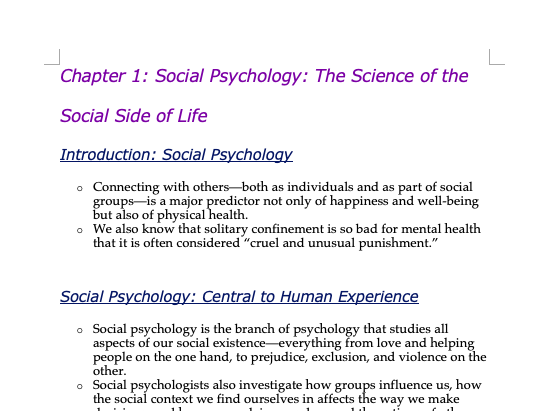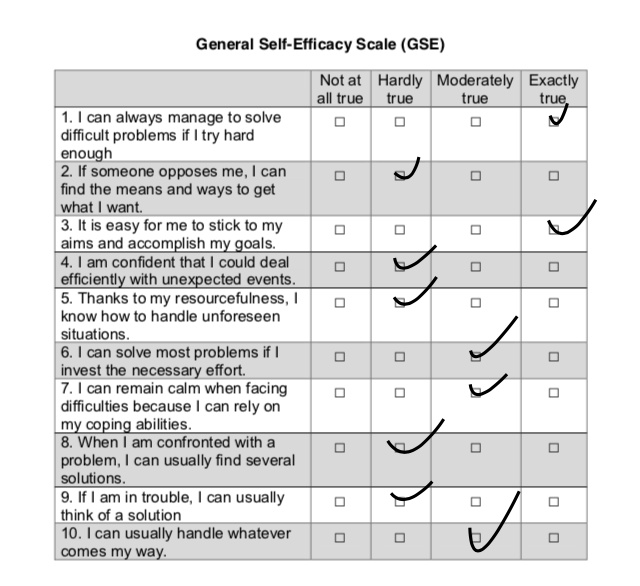Blog 10:
My course expectations aligned with the course outcomes. I believe I achieved all course objectives, especially explaining how attitudes are formed and changed and discussing the factors that influence our liking for other individuals. At the beginning of the course, my attitude about social psychology was that it could be used to influence others and might be manipulative, but now I know it is much deeper than that. It does not present strategies on influencing others, but rather explains how and why we act the way that we do. If I took the course over again, I would set aside more time to reread the textbook to solidify my understanding. I have had a lot of academic growth throughout this semester. I had to become very self-disciplined taking five summer courses, and I will take that discipline with me throughout the rest of my academic career. One course-gained skill I will use in both my professional and personal life is prosocial behavior. Doing nice things for others not only improves your relationship with that person, but also increases your own self-esteem and well-being.

Grade So Far: I chose this image because it represents my academic growth in this course. I have successfully completed many assignments regarding social psychology, so I know I have gained a lot of knowledge in the field.
Blog 9:
The top three things I learned in this course are as follows. The first is self-efficacy, which is mentioned in Blog 2. The second is how prejudice and discrimination are defined, which was observed in Assignment 3 and Assignment Takeaway 3. The third was the positive effects of prosocial behavior, which was observed in Assignment 5 and Assignment Takeaway 5. One concept that applies across areas in the course is self-regulation as described in Blog 7. For example, you need self-regulation for self-efficacy as described in Blog 2. Something I learned in this course that connects to another course is the topic of prosocial behavior. In my positive psychology class, we had a whole unit on prosocial behavior and its positive effects, just like we learned about in this course.

My Social Psychology Folder: This is a screenshot of the beginning of my social psychology folder on my computer. I picked this image because I looked through these files when I was boiling down what I learned for this blog post.
Blog 8:
I found the mating article very interesting. Some ways men upset women are by not giving them as much attention or communication as they would like and not taking care of their environment, such as being messy. Women upset men when they bruise their ego or discount their dreams and aspirations.


Conflicts Between Genders: I chose these two images because they show common ways in which the genders upset each other: men not giving women as much attention as they want, and women hurting men’s egos.
Blog 7:
In my mind, self-regulation is a skill, and emotional intelligence is the level an individual holds of this skill. Self-regulation is needed for emotional intelligence, which to me means being able to acknowledge and express emotions in a functional, healthy way. I display emotional intelligence by using the REST method I learned in Dialectal Behavior Therapy. It is a method used to handle emotional triggers that stands for relax, evaluate, set an intention, and take action. I could improve my emotional intelligence by journaling and remaining calm when interpersonal conflicts arise.

My Emotional Intelligence: I chose this image (a screenshot of my emotional intelligence test score results) because it applies the concept of emotional intelligence to my own life. Now I know that it is average and I have room to improve.
Blog 6:
I felt troubled after watching Kilbourne’s Ted Talk. Prior to watching, I had seen ads that sexualize women. Notably, I saw products that were marketed towards men picture women’s body parts to grab their attention. However, I was not aware that some advertisements go as far as dehumanizing women and normalizing harassment and assault. I found five advertisements that illustrate Kilbourne’s points. The first advertisement shown below criticizes women’s bodies and can make them feel insecure and unable to reach an impossible ideal. The second advertisement sexualizes women, dismembering them for a beer ad. The third advertisement objectifies women, placing them in a beer box like objects. The fourth image sexualizes children, putting make-up and heels on a ten-year-old. The last image normalizes abuse, displaying a man over a woman in a trunk with her legs tied up.

Blog 5:

Pictured are three screenshots from different advertisements. Image A represents a credible source because it involves a dentist speaking on the efficacy of a toothpaste. An expert in the field speaking on the subject makes viewers perceive the information as more credible. Image B represents a non-credible source because the spokesperson for the advertisement is not knowledgeable about the topic he is speaking on. The spokesperson is an actor and comedian speaking on an investing app, which many people believe to be a scam. It is inferenced that the spokesperson knows and cares little about the subject, and is just in it for the paycheck, making him not very credible or persuasive. Image C represents an attractive source because it shows the Kardashians, beauty influencers, advertising their lip products. Ads like these are effective because people see these influencers as the standard of beauty and want to use their products to be more like them.
Blog 4:
I did well on our first exam in this class, only getting two questions wrong. I searched for the correct answers in the textbook and added it to my notes. To prepare for the exam, I took notes on every chapter as I read and watched the jeopardy review videos right before taking the exam. It was a good way to review everything I learned in an engaging way. I will likely continue using this strategy for the next exam because it proved successful for me.

My Notes: This is a screenshot from my notes from Chapter One that helped me study for the exam.
Blog 3:
There exists a connection between music and relationships. I believe most of all, listening to and talking about similar music preferences is a bonding experience between individuals. I notice a big similarity in music preferences between my friends and I. Shared music preference is how I met some of my friends in the first place. You automatically feel closer to someone upon learning they share your music taste. As the Soul Meets Body article stated, you assume you share values with this person. In my case with my friends, we do share similar values, but I know this is not always the case. Some songs that I associate with people and events in my life are listed below. The song for my boyfriend is one we started listening to together when we first started dating and the song for my brother is one he often plays in his car when I ride with him.
highschool by guccihighwaters – my boyfriend
I Hope You Dance by Lee Ann Womack – my parents
Benz Truck by Lil Peep – my brother
Hold by WINNER – my friend
Ribs by Lorde – summer in middle school
Bon Voyage by YooA – nature and new beginnings

Bon Voyage: This is a screenshot from YooA’s Bon Voyage music video. I chose this song and image because I associate them with nature and new beginnings in my life, which make me feel good.
Blog 2:
I believe I am a very disciplined student. I have a schedule/to-do list hybrid, outlining everything due every day of the month. However, my confidence as a student has decreased lately. I used to be days ahead of my schedule, turning things in days before they were due, but now that I am taking five accelerated summer classes, I am finding that I can barely keep up. This decreases my confidence as a student because barely making the deadlines makes me feel inefficient, even though I am trying my best. I do think that there is something I can do to increase my efficiency and decrease my stress: take more true, devoted breaks. I do take breaks now, but they mostly consist of watching a few random videos between assignments, so my day is still all on the computer. During breaks between assignments I should engage in something, like an activity with a friend or getting outside and taking a walk. I should also try to stay calm and not get so stressed and anxious because that will only make things worse. I believe improving upon these factors will increase my self-efficacy. My General Self-Efficacy Scale result was a 27, which is about average. I thought it would be higher since I am so disciplined in my studies, but I failed to realize that self-efficacy also involves confidence, which I seem to lack. Sometimes, when overwhelmed with my studies, my confidence and self-esteem drop dramatically, which I hope to improve on by increasing my resilience.

My General Self Efficacy Scale Results: This is a screen capture of my General Self-Efficacy Scale Results. I chose to include this because it shows that I am disciplined in my work, but lack confidence in dealing with unexpected events and finding several solutions to problems.
Blog 1:
The course objectives outlined in the course syllabus will help me in the future by giving me knowledge that will help me improve my social intelligence. By understanding how people perceive and understand others, I will understand the roots of things that occur in my social life. Also, by understanding the origins and effects of prejudice and discrimination, I will better be able to fight against these ideas. I expect this course will help me understand my social cognition, social interactions, and relationships better. I hope to gain this kind of practical knowledge in this course that I can apply to my own life. To ensure success in this course, I will list all due dates in my planner and keep up with my work. This way things will not pile up towards the end of due dates and I will not get overwhelmed.

Availability Heuristic: This image is a great example of availability heuristics covered in chapter two. These individuals place more importance on the danger of shark attacks because the information is more available to them, while cigarettes and fatty foods actually pose a greater danger.